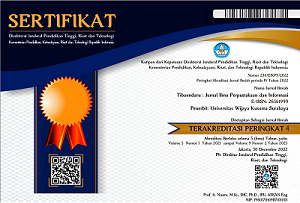Design and Quality Test of OMDIS (Online MeSH & DDC Integrated System) Application for Librarians to Determine DDC Classification Numbers and MeSH-Based Subject Headings
Abstract
The OMDIS (Online MeSH & DDC Integrated System) application is an application designed to facilitate librarians in determining DDC classification numbers and MeSH subject headings in an integrated manner within a network. DDC (Dewey Decimal Classification) is a guideline for the placement/arrangement and retrieval of collections, while MeSH (Medical Subject Headings) is a collection of controlled vocabulary that is organized hierarchically for indexing, cataloging, and searching biomedical and health-related information. Purpose Research. The purpose of this study is to provide an application that can assist librarians, particularly those working in the Indonesian Ministry of Health, in the process of processing library materials, namely to determine MeSH subject headings and DDC classification notations in a single database in accordance with the provisions of Indonesian Minister of Health Regulation Number. 68 of 2016. Research Methods. The OMDIS application was developed using the Research and Development Method at Level 4, which involves creating a new product while testing its effectiveness based on ISO 9126-1 standards and measured using the Likert Scale, where the research sample consisted of librarians from the Malang Health Polytechnic (Poltekkes) of the Indonesian Ministry of Health. resulting in an application that can assist librarians, accessible via https://omdis.web.id/. Result. The result of this research is application that can assist librarians, accessible via https://omdis.bibliothee.web.id/. Conclusion. The OMDIS application is available to assist librarians to facilitate the processing of library materials, especially within the Ministry of Health RI. According to ISO 9126-1, which include Functionality Aspect, Reliability Aspect, Usability Aspect, Efficiency Aspect, Maintainability Aspect, Portability Aspect of OMDIS application, the results of which were tested approaching the VERY AGREE area with an average score of 46.42 with an error rate of 1% .
Keywords: OMDIS; MeSH; DDC; Subject Headings; Library
Full Text:
PDFReferences
Anawati, N. D., Cahyani, I. R., & Sistarina, A. (2022). Pemahaman Dan Kesiapan Pustakawan Terhadap Pemanfaatan Alat Klasifikasi Di era digital. Media Pustakawan, 29(3), 294-308. https://doi.org/10.37014/medpus.v29i3.3468
Budiaji, W. (2018). Skala Pengukuran Dan Jumlah Respon Skala Likert. https://doi.org/10.31227/osf.io/k7bgy
Dai, S., You, R., Lu, Z., Huang, X., Mamitsuka, H., & Zhu, S. (2019). FullMeSH: Improving large-scale mesh indexing with full text. Bioinformatics, 36(5), 1533-1541. https://doi.org/10.1093/bioinformatics/btz756
DeMars, M. M., & Perruso, C. (2022). MeSH and text-word search strategies: Precision, recall, and their implications for library instruction. Journal of the Medical Library Association, 110(1). https://doi.org/10.5195/jmla.2022.1283
Dewey services: Improve the organization of your materials. (n.d.). OCLC. https://www.oclc.org/en/dewey.html
Fox, V. B., & Kyrios, A. (2021). Dewey decimal classification, 2021 (Introduction, manual, tables, schedules 000-199) (Volume 1 of 4).
Fox, V. B., & Kyrios, A. (2021). Dewey decimal classification, 2021 (Schedules 200-599) (Volume 2 of 4).
Fox, V. B., & Kyrios, A. (2021). undefined.
Guo, Z., You, Z., Huang, D., Yi, H., Zheng, K., Chen, Z., & Wang, Y. (2020). MeSHHeading2vec: A new method for representing mesh headings as vectors based on graph embedding algorithm. Briefings in Bioinformatics, 22(2), 2085-2095. https://doi.org/10.1093/bib/bbaa037
Hider, P., & Harvey, R. (2008). Organising knowledge in a global society: Principles and practice in libraries and information centres. Elsevier.
Kusmayadi. (2019). Kajian Software. Universitas Terbuka.
Kusmayadi. (2022). Teknologi Komunikasi dan Informasi. Universitas Terbuka.
Lailela, S. N., & Kusumadiarti, R. S. (2018). Pengukuran kualitas perangkat lunak aplikasi sisfo_nilai di POLITEKNIK PIKSI Ganesha berdasarkan ISO 9126. Jurnal E-Komtek (Elektro-Komputer-Teknik), 2(2), 84-100. https://doi.org/10.37339/e-komtek.v2i2.96
Mude, M. A., & Ilmawan, L. B. (2024). Perancangan sistem web berbasis ISO 9126-4. Journal of Information System Management (JOISM), 5(2), 214-218. https://doi.org/10.24076/joism.2024v5i2.1420
Mulyadi, S. (2023). Pengelolaan Otomasi Perpustakaan Berbasis Senayan library management system (SLIMS). PT. RajaGrafindo Persada - Rajawali Pers.
Mohamad, R. (2019). Freeware E-class untuk Memudahkan Siapa Saja Mengklasifikasi Dan Memahami Sistem Klasifikasi Berbasis DDC. Tibanndaru : Jurnal Ilmu Perpustakaan dan Informasi, 3(1), 55. https://doi.org/10.30742/tb.v3i1.682
Mohamad, R, (2021). Understanding DDC #1: Langkah Awal Memahami Skema Klasifikasi DDC (Teori dan Aplikasi). Dinas Kearsipan dan Perpustakaan.
Saini, G. L., & Panwar, D. (2020). Comparative study of open source software quality models. Journal Of Intelligent Systems And Computing, 1(1), 46-55. https://doi.org/10.51682/jiscom.00101004.2020
Sari, I. N., Lestari, L. P., Dedy Wijaya Kusuma, S., Brata, D. P., Karwanto, Supriyono, Iffah, J. D., Widiatsih, A., Utomo, E. S., Maghfur, I., Sofiyana, M. S., & Sulistiana, D. (2022). Metode Penelitian Kualitatif. UNISMA PRESS.
Sugiyono. (2019). Metode Penelitian & Pengembangan Reserch and Development. Alfabeta
Undang-Undang Republik Indonesia Nomor 43 Tahun 2007 tentang Perpustakaan. 2007. Jakarta: Perpustakaan Nasional.
Yarshini Thamilarasan, Raja Rina Raja Ikram, Mashanum Osman, & Lizawati Salahuddin. (2023). A review on software quality models for learning management systems. Journal of Advanced Research in Applied Sciences and Engineering Technology, 32(2), 203-221. https://doi.org/10.37934/araset.32.2.203221
DOI: http://dx.doi.org/10.30742/tb.v9i2.4551
Refbacks
- There are currently no refbacks.

This work is licensed under a Creative Commons Attribution-NonCommercial 4.0 International License.
Tibanndaru: Jurnal Ilmu Perpustakaan dan Informasi is indexing by:
Reference Management Tools

![]()


.png)







